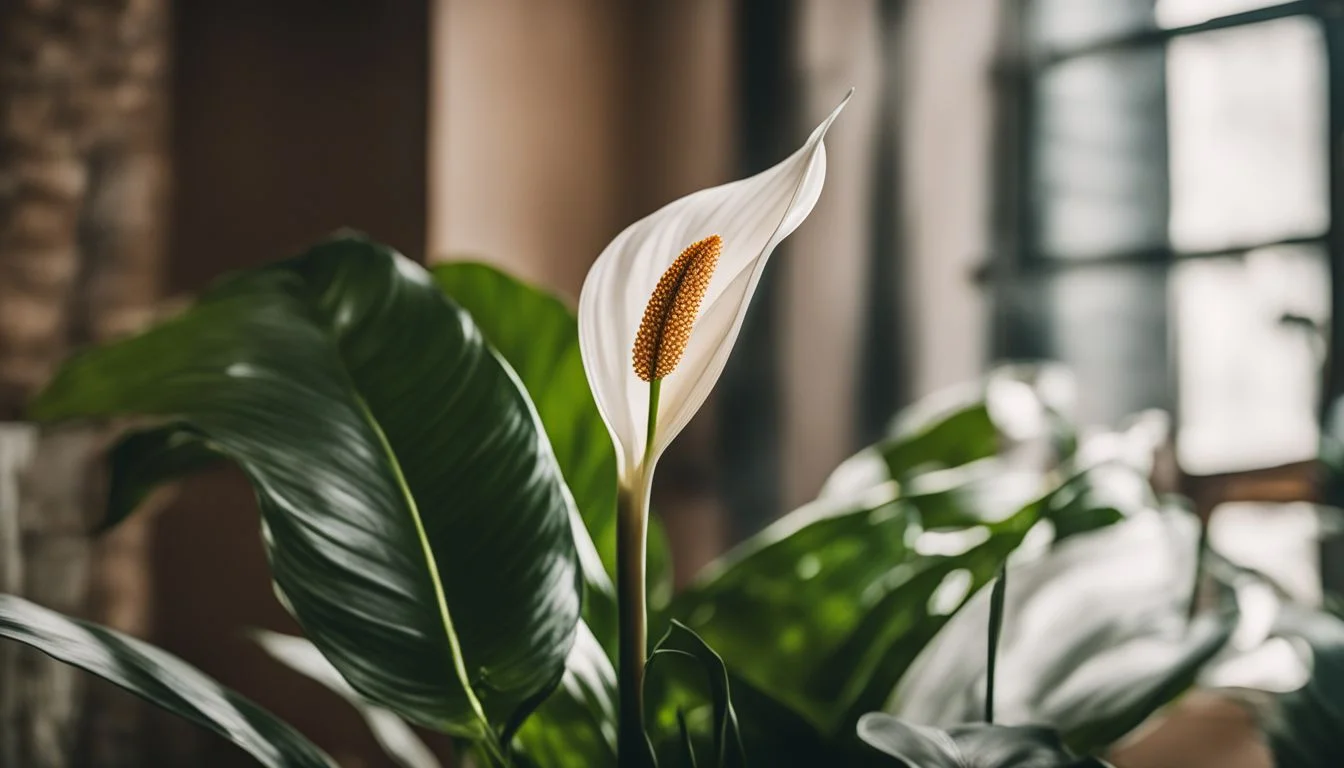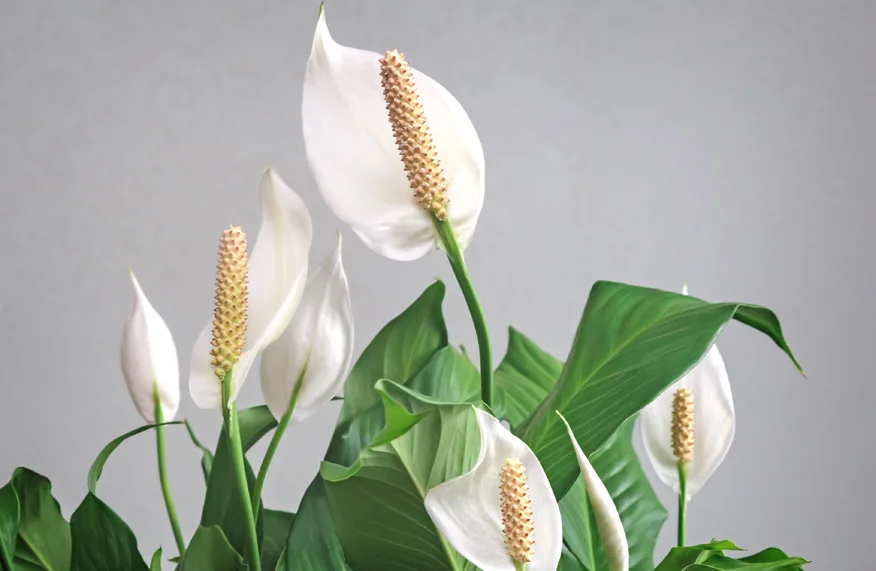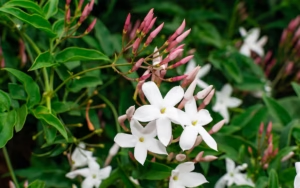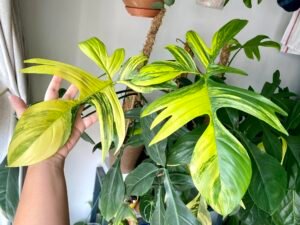Peace Lilies (Spathiphyllum), with their lush green leaves and striking white blooms, are one of the most popular houseplants around the world. Known for their elegance and air-purifying qualities, these plants are both beautiful and functional. Whether you’re a novice gardener or a seasoned plant lover, this guide will walk you through everything you need to know about growing, caring for, and troubleshooting Peace Lilies. Let’s dive in!
How to Plant, Repot, and Divide Peace Lilies
Planting Peace Lilies
Planting a Peace Lily is a straightforward process, but getting it right ensures your plant thrives for years. These tropical beauties prefer slightly acidic, well-draining soil to mimic their native rainforest environment.
- Choose the Right Pot:
- Pick a pot with drainage holes to prevent water from sitting at the bottom, as Peace Lilies hate soggy roots.
- A ceramic or plastic pot is ideal to retain moisture while allowing adequate drainage.
- Prepare the Soil:
- Use a rich potting mix with peat moss, perlite, and compost. You can also add a small amount of sand for extra drainage.
- Ensure the soil is slightly moist before planting.
- Plant Your Peace Lily:
- Gently loosen the root ball of the plant if it’s root-bound.
- Place the plant in the pot so that the top of the root ball is about an inch below the rim.
- Backfill with soil and press gently around the base to secure the plant.
- Water Thoroughly:
- Water the plant immediately after planting until you see water draining out the bottom of the pot.
Repotting Peace Lilies
Repotting is essential for Peace Lilies, as their roots can quickly outgrow their containers. Typically, Peace Lilies need repotting every 1-2 years, depending on their growth.
- When to Repot:
- Signs include roots growing out of drainage holes, soil drying out quickly, or the plant becoming top-heavy.
- How to Repot:
- Carefully remove the plant from its current pot. Tap the sides of the pot to loosen the soil if needed.
- Shake off excess soil and inspect the roots. Healthy roots are white and firm. Trim any brown, mushy, or damaged roots.
- Choose a new pot that is 1-2 inches larger in diameter.
- Place fresh soil in the bottom of the new pot, position the plant, and fill in around the roots with soil.
- Aftercare:
- Place the plant in a spot with indirect light to minimize stress.
- Water it well and monitor its health over the next few weeks.
Dividing Peace Lilies
When your Peace Lily becomes too large for its pot or overcrowded, it’s time to divide it. Division not only rejuvenates the plant but also gives you new plants to expand your collection or share.
- When to Divide:
- Spring is the best time to divide Peace Lilies, as the plant is in its active growth phase.
- How to Divide:
- Gently remove the plant from its pot.
- Separate the root ball into smaller sections, ensuring each section has at least two or three leaves and a portion of healthy roots.
- Use a clean knife or scissors if the roots are tangled and difficult to separate.
- Potting Divisions:
- Plant each division into its own pot with fresh potting mix.
- Water well and place in a shaded area for a week to allow the plants to recover.
Peace Lily Care
Light Requirements
Peace Lilies thrive in indirect light, making them perfect for spots like offices or rooms with filtered sunlight. Bright light helps them flower, but they’re also tolerant of low light. However, avoid placing them in direct sunlight, which can scorch their leaves and turn them brown.
Watering Peace Lilies
Proper watering is critical for Peace Lilies, as they are sensitive to both overwatering and underwatering.
- Watering Tips:
- Use lukewarm, filtered, or distilled water to avoid mineral build-up, which can damage the plant over time.
- Water when the top inch of soil feels dry. Stick your finger into the soil to check.
- Signs of Watering Issues:
- Underwatering: The plant wilts, but perks up quickly after watering.
- Overwatering: Leaves turn yellow, and the soil feels soggy.
- Humidity Requirements:
- Peace Lilies thrive in high humidity. If your home is dry, mist the plant regularly or use a humidifier.
Temperature and Environment
These tropical plants love warmth. Keep your Peace Lily in temperatures between 65°F and 85°F. Avoid cold drafts or placing them near air conditioners and heaters, as sudden temperature changes can stress the plant.
Fertilizing Peace Lilies
Feed Peace Lilies every 6-8 weeks during spring and summer. Use a balanced liquid fertilizer diluted to half strength. Avoid over-fertilizing, as it can lead to burnt leaf tips and poor growth.
Propagating Peace Lilies
The most effective way to propagate Peace Lilies is by dividing the plant. Unlike some houseplants, they cannot be propagated through cuttings or leaves alone.
- Steps to Propagate:
- Wait until the plant is mature with multiple clumps of leaves.
- Follow the division method described earlier.
- Rooting in Water:
- While Peace Lilies don’t grow new plants from cuttings, you can grow them in water by keeping the roots submerged in a clear vase or jar. Change the water weekly to prevent bacterial growth.
Common Pests and Plant Diseases
Common Pests
Although Peace Lilies are relatively pest-resistant, they can sometimes attract the following:
- Spider Mites: Tiny pests that create webbing on leaves. Treat by spraying the plant with water and using neem oil.
- Mealybugs: Cottony white clusters that weaken the plant by sucking its sap. Remove them manually with a cotton swab dipped in rubbing alcohol.
- Scale Insects: Small, immobile brown pests that stick to stems and leaves. Use insecticidal soap for control.
Common Diseases
Peace Lilies can face fungal and bacterial issues, often due to improper care:
- Root Rot:
- Cause: Overwatering and poor drainage.
- Solution: Repot the plant in fresh, well-draining soil and trim affected roots.
- Leaf Spot:
- Cause: Fungal infection from excess moisture on leaves.
- Solution: Water the soil directly and improve air circulation.
Common Problems With Peace Lilies
- Yellow Leaves:
- Cause: Overwatering, underwatering, or aging.
- Solution: Adjust watering habits and trim off old, yellowing leaves.
- Brown Leaf Tips:
- Cause: Dry air, over-fertilization, or poor water quality.
- Solution: Increase humidity, dilute fertilizer, and use distilled water.
- Drooping Leaves:
- Cause: Underwatering or sudden temperature changes.
- Solution: Water thoroughly and keep in a stable environment.
How to Get Peace Lilies to Flower
Peace Lilies are prized for their white flowers (spathes), but sometimes they refuse to bloom. To encourage flowering:
- Light: Provide bright, indirect light for at least six hours a day.
- Fertilizer: Use a phosphorus-rich fertilizer during spring.
- Stress Period: Temporarily place the plant in a cooler location (60°F) for a few weeks to stimulate flowering.
Types of Peace Lilies
- Spathiphyllum Wallisii: A classic variety with medium-sized leaves and flowers.
- Domino Peace Lily: Distinguished by its striking variegated foliage.
- Spathiphyllum Sensation: A larger variety, perfect for spacious interiors.
- Petite Peace Lily: A compact version ideal for small spaces.
Frequently Asked Questions (FAQ)
Can Peace Lilies Be Grown in Water?
Yes, Peace Lilies thrive in water. Keep the roots submerged and avoid wetting the crown to prevent rot. Replace the water weekly to keep it fresh.
Is the Peace Lily Toxic to Cats and Dogs?
Yes, Peace Lilies contain calcium oxalate crystals, which are toxic to pets if ingested. Symptoms include drooling, vomiting, and difficulty swallowing. Keep the plant out of reach of pets.
Do Peace Lilies Grow Better in Sun or Shade?
Peace Lilies prefer shade or low light conditions but will bloom better in bright, indirect light. Avoid direct sunlight.
What Are the Disadvantages of Growing Peace Lily Plants?
- Toxicity: Harmful to pets and children.
- Humidity Needs: Requires consistent humidity levels.
- Water Sensitivity: Overwatering or poor water quality can harm the plant.
How Do I Tell if My Peace Lily Is Overwatered?
- Yellowing leaves, a musty smell, and soggy soil are tell-tale signs. Reduce watering and check for root rot.
Read also: https://techcrunchs.net/how-to-grow-and-care-for-snake-plant/










